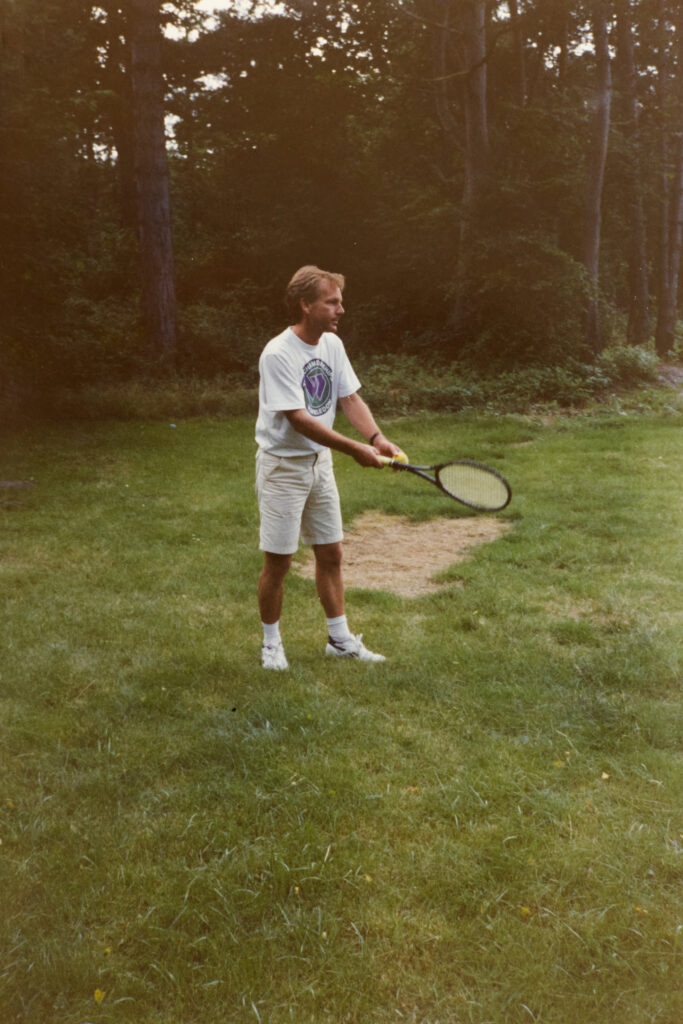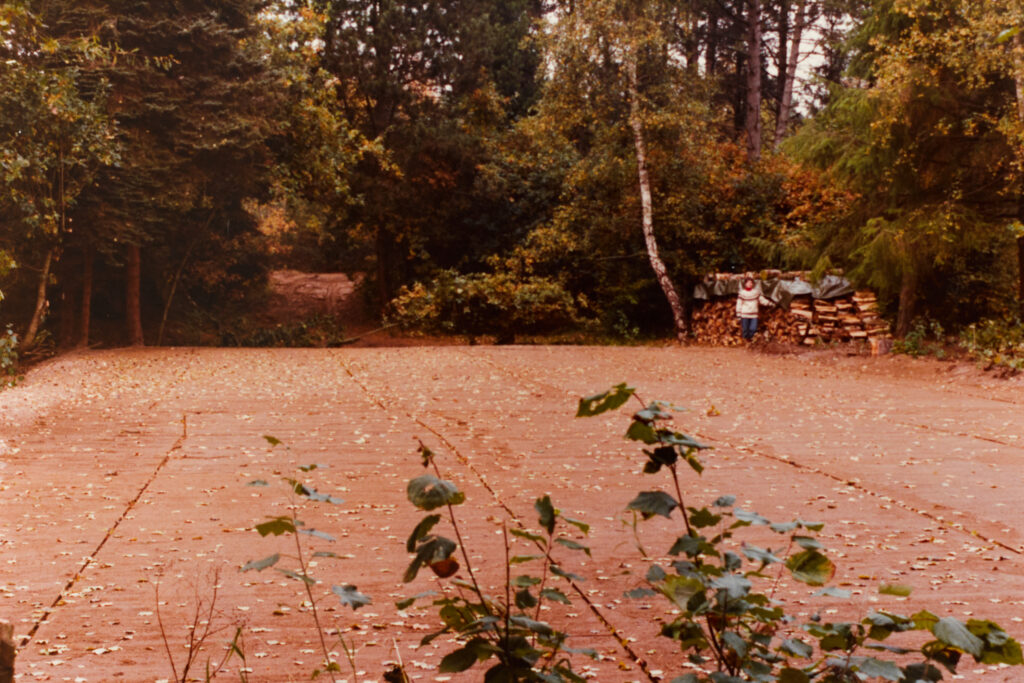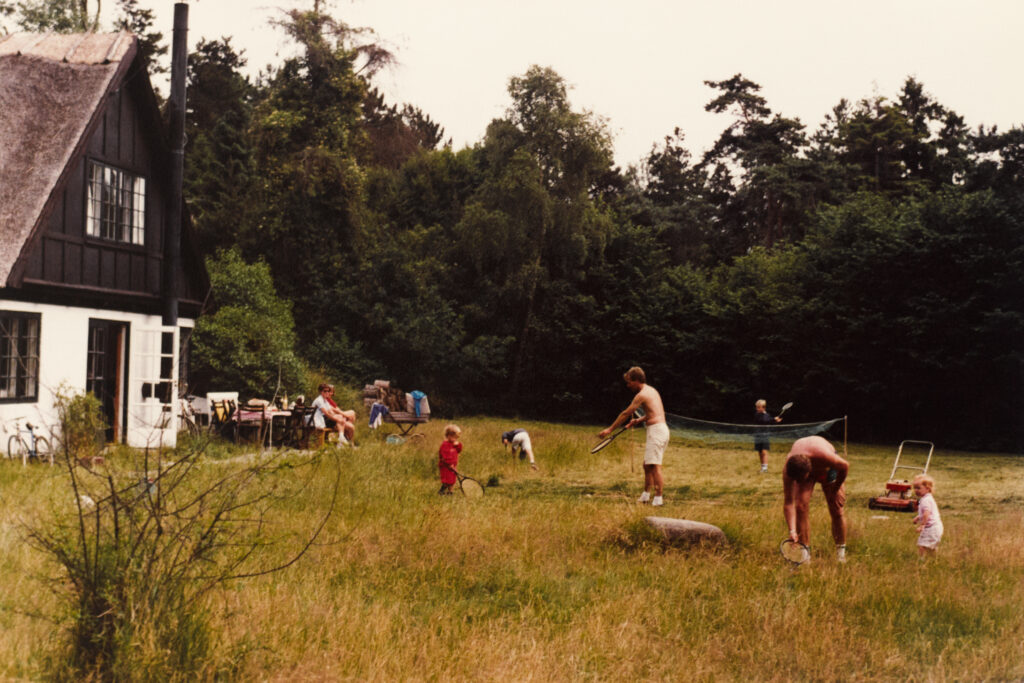By Nikolaj Møller
My father built the court 35 years ago. Though no one in our family knows the exact year it was built, we have an old receipt from 1989 for the first net we bought. Thus, we dubbed ‘89 as the official beginning of the court.
He built the court while still working. He worked in advertising, and worked a lot. In the late 70’s, he and my mother bought the summerhouse, not long before I was born. Some years later they managed to buy a little piece of forest next to the house—where the court now lives. At the time, all of my family played tennis: my father, mother, older brother and sister played on a pretty high level. As a result, my father got the idea to make a tennis court for the family, choosing grass as the surface.
There were two reasons for choosing grass. The first being that it was less expensive to make than other surfaces. This turned out to be very wrong. Considering the amount of hours working on it, the machinery needed throughout the years etc. Nonetheless, at the time, it was a reason. The second, and most important, reason was that he wanted to court to be in symbiosis with the forest and nature, explaining why he choose not to fence it. The court is there as part of its surroundings. Sometimes a bit greener, a bit flatter, with less dandelions but still.

With that said my father, of course, loved grass tennis. In the years the court was being built, we went to Wimbledon, watching Ivan Lendl, Sabatini, and Connors. So there was definitely a love for grass tennis and Wimbledon to begin with.
I was just a kid, I can’t remember it being built. I remember playing on it, but it took me years to really understand the importance of it, for our family, for my father. There’s a very special aspect of grass tennis that goes beyond its surface and style of playing. Because our court is unfenced, in the middle of nature it really invites people to play, and enjoy playing. Kids playing barefoot, running around and falling like it was any other grass field. My father discovered this very early. The effect it had on people and how it brings people together.
However, the court’s beginning wasn’t as good as it is now. We have less clay in the ground in Denmark as in England, so it’s softer and takes a lot of work to make it hard enough to play on. Back then, this was the work of my father alone. Now, my brother and I help more, but it really is the work of my father. As far as we know, it is the only grass court of such quality in Denmark. Yet, my father always wished there were others. So he could share advice. His friend once invited him to All England Lawn Tennis & Croquet Club (AELTC) to meet the head groundskeeper, Neil Stubley. Stubley gave him the trick to use an old net tied to a ladder to spread out one ton of sand, top dressing, end of season. To let it sink into the ground making the court harder.
After my father retired it gave him more time to work on the court, its quality slowly improved. I think he began to enjoy it more. In many ways the court became his sanctuary. He loves to see people enjoy playing on it, whether they’re his grandchildren, friends, or family. But he also genuinely loves the work. Sometimes when I wake up and look out the window, I see him on the court. Working. It can be an unenjoyable cold, misty, and wet morning in late fall, and he is still out there. He says the only time he doesn’t work on the court is when it snows. The struggle of a grass court, but also its special beauty, is that it is nothing if you can’t play on it. We can only play the two summer months of July and August, maybe three with June, yet it demands work all year round. That work is my father’s honour, his pleasure, his mediation and where he enjoys being. He told me once that “some people tend their roses, I tend my grass court. There’s no difference.”
My first exposure to tennis was, of course, our grass court. My first memory is playing with my older sister at a club close to our home. She was good. I was just a kid trying to hit the ball hard and make her run. I remember her telling me, in a very firm way, that a warm up is to hit to each other, not to try and out play each other. I still remember that as an education into the elegance of tennis. All the unwritten rules. The grass court has a lot of rules like those. Every season, we bought a big box of Tretorn balls, but because there was no fence, all the balls would fly out into the forest. So when playing on our court there are specific ways, not exactly rules, but ways to play. If the ball goes out in the forest, you look at where it stops but don’t search for it until there’s a break in the game. You always try to stop a ball before it goes out into the forest. All these little simple things were what made a little kid like me think about more than just playing–something I remember being proud of.
Because it demands a lot of work, there are so many aspects of the court specific to the game itself. First of all, you can’t play before you’re sure it’s ready. Mowing the grass, sometimes twice and making the lines with our old, worn down chalk machine takes effort. All of these being daily tasks means my exposure to tennis has come with a different kind of respect. You see all the work being put into it before you step on the court to play for a few hours.

One day during COVID I was with my family in the summerhouse watching my father work on the court. suddenly, I began to see him as a man walking alone on a square, trying to make sense of it; trying to perfect it. All of the sudden, This square, this court, became a metaphor for life; we all try to arrange things in our little box meanwhile the outside world is going crazy. I did a documentary about an Afghanistan War veteran who came back from the war with PTSD and moved deep into the Amazon Jungle trying to cure himself with plant medicine. Though the story of my father working on a tennis court is fundamentally different, there was still something that reminded me of it— A man alone, working in nature.
So I took up a camera and started filming him. Very much to his annoyance as he would’ve either preferred to be alone or to have me help him. Nonetheless, he accepted my presence with the camera. I had just become a father myself about half a year before, and when you become a father you begin to see your own father differently. You also see yourself as a son differently. It also had to do with COVID and its effects on many people. I used to think all notable stories happened far away, deep in the jungle or in some deserted town on the other side of the world. Yet suddenly, I realised it was just in front of me: my father on the grass court. I made the film slow, long and with almost no dialogue. Though it was not exactly a tangible method to catch viewership, it was important for me that the viewer felt there with him, in his setting, in his tempo. I wanted the film to be a testament to his work, and too him. Nothing last forever. The film was my way to document that process as an observer but also as a son.
My father wrote an email to my brother and me not long before I started filming. It was pretty straightforward about the work he’d done:
A message from the court -it has been vertically cut, raked, potassium chloride has been added, there has been punched holes in the soil with a lawn aerator, it has been mowed, sulfur granules has been added, and there has been sown, topdressing added and swept. Occasionally a number of dandelions have been removed with the dandelion puller and followed up by a mixture of grass seeds, fertiliser and sand. It has been mowed and fertilized today before the rain, so we are almost ready. It is just to keep the next generations of greenkeepers informed about the work so you are ready to take over
Love,
Dad

It hit me. It was the first time I really understood the importance of the court, the heritage. But also that he will not be here forever, that the work will be our responsibility; so you are ready to take over. The straightforwardness of the email really touched me– it was an email only a father could write.
Seeing how the court makes it closer as a family, through generations, means everything. It makes me proud. It makes me feel closer to my own father. When my son runs out the door, he dashes to the court because he sees my father. It is a very special feeling– almost like time is going backwards. It’s what I did as a kid just a little older than my son is now. It is me being at my fathers age when I was a child. It is memories replaying in real time and it is time moving fast and disappearing at the same time. My son was playing tennis in diapers when he could barely walk. He is there when it rains, wanting to play all the time. To me it is the strongest feeling of love because it is a feeling of unity. In many ways it makes the tennis court more about family, about life and love, responsibility and generations to come. Not just about tennis. But it can only be like that if it is as close to perfection as possible. Otherwise it is not a grass tennis court.
Nikolaj Møller was born in Toronto, Canada and raised in Copenhagen, Denmark. He has worked his way through a range of photographic disciplines over the past years; gallery shows, magazine commissions, publications, advertising and moving images. His work lies in the field between documentary and conceptual visual storytelling, in which his projects evolve and come to life.


